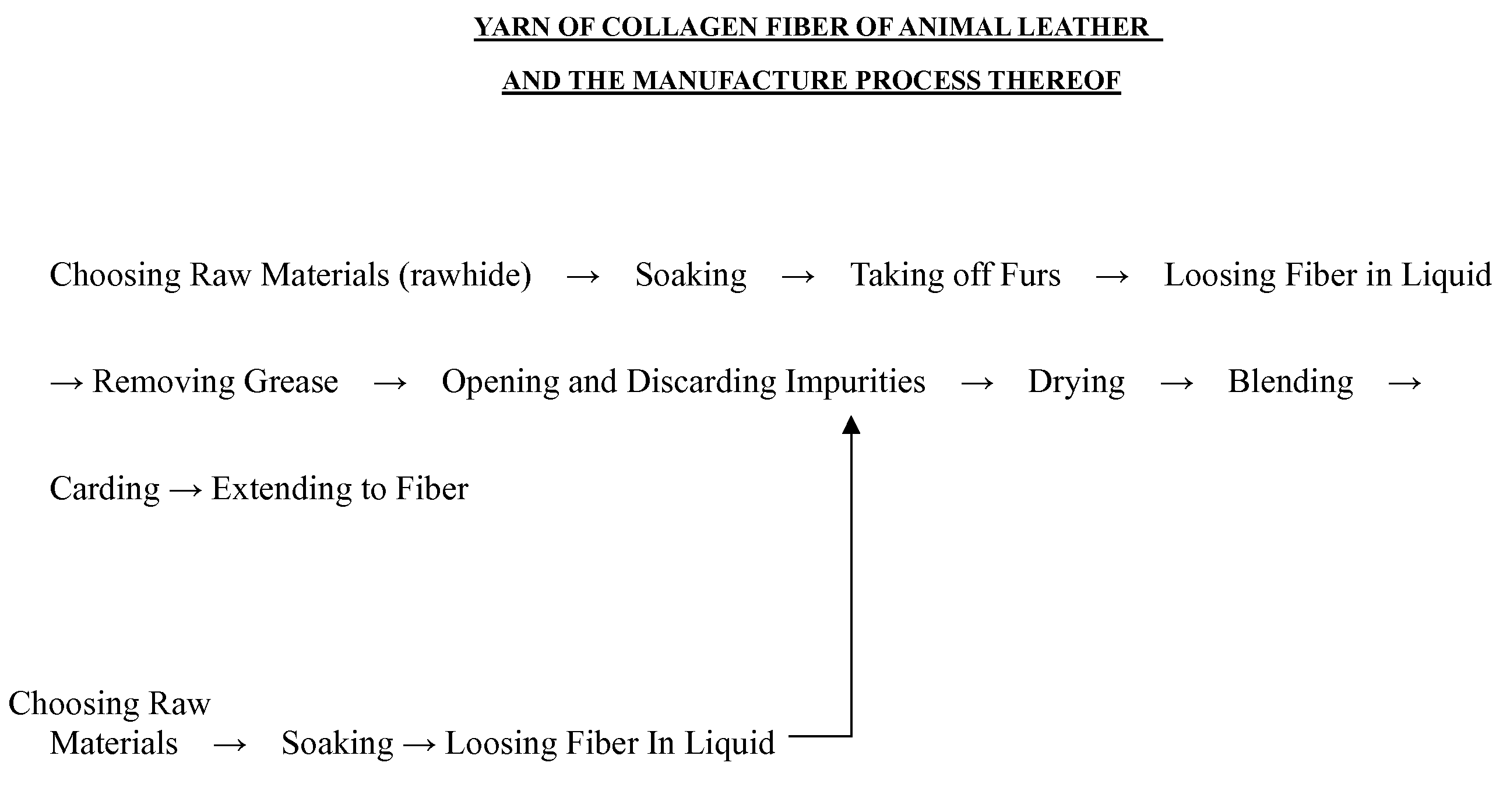Yarn of animal collagen fiber and manufacture process thereof
a technology of animal collagen fiber and manufacturing process, which is applied in the manufacture process, can solve the problems of poor water adsorption, comfort and flame retardant, and high cost and relative low abrasion resistance and tensile strength of synthetic fibers, and achieve excellent properties, broaden the application field of animal collagen fiber, and improve the utilization of leather
- Summary
- Abstract
- Description
- Claims
- Application Information
AI Technical Summary
Benefits of technology
Problems solved by technology
Method used
Image
Examples
example 1
[0012]The animal collagen fiber is 55 WT %, and textile fiber is 45 WT %. The yarn is made of animal collagen fiber and other textile fibers. The bunchy collagen fibers which are occasionally divided into several strands of thinner bunchy collagen fibers incorporate other textile fibers or other collagen fibers to form a kind of continuous blended fiber bundles, which are twisted as a blended fibers.
[0013]The flow processes: choosing raw materials—loosing fibers—assorting—blending—carding—drawing—twisting.
[0014]Description of the Working Procedure
[0015]1. Choosing raw materials: According to the above proportions, at least one of a tanned animal leather and leftover material thereof and wasted leather preparation is selected, wherein the animals include a bull, a sheep, a horse, a pig, a dog, a deer, a rabbit, a crocodile or a snake, and so on, and at least one of the synthetic textile fibers or natural textile fibers is selected.
[0016]2. Loosing fibers: Fibers are loosened by a rec...
example 2
[0022]Animal collagen fibers are 100 WT %. The yarn is made of animal collagen fiber. The collagen fibers are bunchy in yarns and are occasionally divided into several strands of thinner bunchy collagen fibers. The thinner bunchy collagen fibers incorporate other collagen fibers. In this way, the bunchy collagen fibers, continuously separated and incorporated, form a strand of continuously twisted yarns of animal collagen fiber.
[0023]The flow processes: choosing raw materials—liming—washing with water—deliming—tanning and softening—dehydrating—loosing fiber—assorting—blending—carding—twisting.
[0024]Description of the Working Procedure
[0025]1. Choosing raw materials: At least one kind of animal rawhide is selected. The animal includes a bull, a sheep, a horse, a pig, a dog, a deer, a rabbit, a crocodile and a snake, and so on.
[0026]2. Liming: the method for liming with calcium hydroxide as the primary ingredient is used, adding 1-3 percent (weight of rawhide) sodium sulfate and 0.1-0...
example 3
[0035]The animal collagen fiber is 20 WT %, and textile fiber is 80 WT %.
[0036]The processing procedures are similar to those of Example 2.
[0037]Description of the Working Procedure
[0038]1. Choosing raw materials: Selecting wasted materials of rawhide edge or leftovers of gray skin prior to leather-making procedures or double layer skin unsuitable for leather-making or animal hides unsuitable leather-making and endermic tissue layer.
[0039]2. The procedures for liming, washing with water, tanning and softening, and dehydrating are similar to those of example 2.
[0040]3. The fiber filaments produced by the procedures of example 2 combine other filaments or yarns to twist to form mounting yarns or yarns having the above collagen fiber ingredients, the remaining procedures are similar to those of example 1.
PUM
| Property | Measurement | Unit |
|---|---|---|
| temperature | aaaaa | aaaaa |
| temperature | aaaaa | aaaaa |
| temperature | aaaaa | aaaaa |
Abstract
Description
Claims
Application Information
 Login to View More
Login to View More - R&D
- Intellectual Property
- Life Sciences
- Materials
- Tech Scout
- Unparalleled Data Quality
- Higher Quality Content
- 60% Fewer Hallucinations
Browse by: Latest US Patents, China's latest patents, Technical Efficacy Thesaurus, Application Domain, Technology Topic, Popular Technical Reports.
© 2025 PatSnap. All rights reserved.Legal|Privacy policy|Modern Slavery Act Transparency Statement|Sitemap|About US| Contact US: help@patsnap.com


